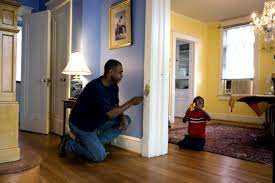Interior House Painting: An Ultimate Guide About Interior House Painting Cost With Details

Investing in the interior painting of your house is a worthwhile investment whether you hire a professional or do it yourself (go for it!). A project like interior painting has a lot of variables that determine the cost. Is it going to be a professional job, or will it be a DIY project?
How ample is the space, what is the condition of the surfaces, and what is your preferred type of paint? Understanding the process and preparing yourself with good information can help you keep costs down if you plan to hire a professional. This guide will give you details about interior house painting costs with more details.
Interior house painting cost
According to research, an interior house painting project typically costs between $3 and $9 per square foot. Painting a room usually costs between $375 and 950. Therefore, the average cost to paint the entire interior ranges between $3,000 and $10,500, including labor and materials.
Depending on the type of paint, the interior size, and the contractor’s wages, repainting a wall ranges between $1,800 and $5,400. The average cost of painting 2,000 square feet is $4,000 and $6,500. On the other hand, you’ll have to spend more money painting doors, trim, ceilings, and baseboards. You should expect to pay between $2.00 and $6.00 more per square foot.
What does it cost to have professionals paint the interior of a house?
Interior painting professionals generally charge between $2 and $6 per square foot. You can expect to pay between $2,000 and $6,000 for a 1,000 square foot home. The price can also vary depending on the paint you choose or the paint the professional prefers.
In addition to the cost of painting the walls, the professional price will depend on the amount of trim, ceilings, and other areas that need to be painted. Materials and labor should be included in the estimate. You may want to ask the following questions:
- Will the painters move furniture?
- Will there be drop cloths on the floors and counters, or will that be your responsibility?
- Does the estimate include repairs to walls, a primer for water stains, and toning down dark walls?
How much does it cost to paint the interior of a house by yourself?
You can expect to pay between $1 and $3 per square foot to paint the interior yourself, about half the cost of hiring a professional. Paint costs about $20 per gallon for low-end brands and $30 to $55 for higher-end brands. A bedroom of average size will require at least two gallons of paint to cover it completely.
Read more: What Is a Salt Lamp and How to Use Salt Lamps? Different Light Bulbs for Salt Lamps
It would help if you also thought about what paint supplies you will need. You can buy these for $10 to $100, depending on whether you’re adding to your inventory or starting from scratch. Other supplies you will need include:
- The Rollers
- The Paintbrushes
- The Buckets
- The Paint
- The Tape
- The Drop cloths
- The Rental equipment
- The Safety goggles
- The Paint filter mask
- The Ladder
The time it takes to paint one room depends on the number of coats and any extra work, such as trimming. Consider how much time and supplies you will need when estimating how much it will cost to paint your living spaces. Only you can calculate the value of your time.
Interior painting: How to save money?
Saving money by cutting corners can leave you unsatisfied with the final product. If you need to lay down a primer, make sure you purchase the appropriate paint and don’t skip steps. It would help if you didn’t try to save a few cents by using cheap supplies. Instead, focus on these things:
1. Use borrowed supplies
The cost of brushes, rollers, sponges, and tarps can quickly add up. You might consider borrowing paint supplies from neighbors and friends. A kit with everything you need can be purchased from an online resource, and you can save money by buying everything at once instead of separately.
2. Decide whether you need primer.
Primers increase your overall costs, but you may not need them. When painting over existing finishes of the same type that are clean, dry, dull, and in good condition, you can skip this step. Rick Watson, Sherwin-Williams’ director of product information and technical services, says latex can be converted into latex or oils.
“We recommend primers when it is necessary to promote adhesion, block stains, fill porous surfaces such as concrete block, resist alkali and efflorescence, provide corrosion resistance, or go from dark to white,” Watson explained. Otherwise, you should save your money.
3. Measure your rooms
Measuring correctly before you begin prevents you from wasting money on paint and supplies that can’t be returned. The number you end up with determines how much paint you will need. Measure the length of the ceiling if you are painting it. By multiplying that number by the ceiling width, you can determine how much paint will be needed for the roof, independent of the walls.
Be sure to add 10 percent to cover any mistakes in your calculations. By doing this, you can be sure to have enough paint to complete the job. An online paint calculator can give you the exact amount of color you need.
4. Choose the right paint for your space
Choosing the right paint before you get started on your project is one of the most important things you can do. Even though flat and matte finishes are cheaper, they are harder to clean than eggshell or satin finishes.
Be sure to take into consideration how the room will be used. Children and dogs will be spending a lot of time in high-traffic areas, so the paint needs to be more durable. The paint on the ceiling is thicker and adheres better to the surface than wall paint.
Watson says some paints are more durable and washable than others. “Some paints are designed to cover an interior smoothly with rich hues and special sheens, and some can even help sanitize or eliminate odors.”
How to paint the interior of a house?
Make sure the walls are prepared for painting before you begin. You can use a good cleaner and degreaser (read the label to see if you should dilute it) or an emulsifying soap to clean the walls and thoroughly paint the trim. Rinse the walls thoroughly with clean water and allow them to dry completely.
Patching any holes in the wall with a wall repair patch kit is a good idea at this time. Patches, scuffs, gouges, and other imperfections should be sanded to create a smooth surface. Finally, wipe down the walls with a clean, damp rag to remove any remaining dust.
Now it’s time to paint! Begin at the top and work your way down. Paint the ceiling and then the walls. Trim and doors are the last steps.
Which interior paint is long-lasting?
Interior paint plays a crucial role in enhancing the appearance of a room and protecting the walls from daily wear and tear. When choosing a long-lasting interior paint, there are several factors to consider. One of the most important is the quality of the paint itself.
High-quality paint is made with premium ingredients that make it more durable, resistant to fading and chipping and retain its original color for longer. Another important factor is the finish. Paint with a high-gloss or semi-gloss finish is more durable than one with a matte finish, as it is easier to clean and less likely to stain.
Some of the best options for long-lasting interior paint include brands like Behr, Sherwin-Williams, and Benjamin Moore. These companies have a reputation for producing durable and beautiful paint. They offer a range of paint products designed to meet the specific needs of different rooms, such as high-traffic areas, low-light rooms, and moisture-prone spaces. Whether you’re looking for paint that is easy to clean, resistant to fading, or just plain beautiful, one of these long-lasting interior paint options is sure to meet your needs.
Conclusion
Homeowners often have the most fun when choosing the paint color for their painting project. A decision like this requires a lot of research, and there are a variety of resources available online. You should, however, choose interior paints that are free of harmful side effects, regardless of the color you desire. In many paints, volatile organic compounds (VOCs) are present.
High levels of volatile organic compounds (VOCs) have been linked to health issues in long-term exposed individuals. Baby’s oxygen inhalation rate is also higher than adults’, making it harmful to them. Paints with low volatile organic compounds or low odors are available. Any color you can imagine can be tinted onto them.




